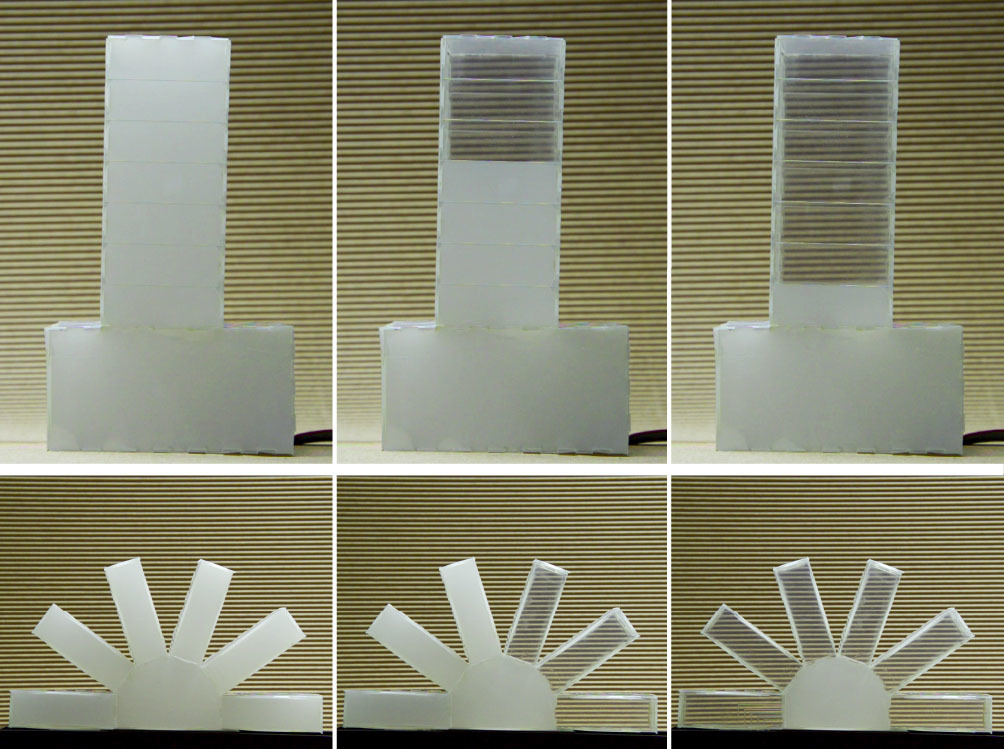European researchers have created a new composite material with variable transparency
Materials with variable transparency are not new, but a group of German and Danish scientists have seriously advanced in this matter. In their work, the researchers describe the polymer-dispersed material based on liquid crystals (PDLC) they create, which changes its transparency from completely transparent “plastic” to “deaf” white faster and more accurately than other similar developments. The material becomes transparent in 8 milliseconds (instantly for the human eye), and opaque in 80 milliseconds. Officially, the novelty will be presented in October as part of the UIST 2016 technology symposium , which will be held from October 16 to 19 in Tokyo, Japan.
To participate in the UIST 2016 group prepared a special presentation video, which is already available on Youtube:
Models created with the help of a new material, very reminiscent of inseparable origami figures, which are classically made from a single sheet of paper. On the folds of the "sheet", the researchers make special contacts that allow to separate and control the individual segments. The transparency of the material is changed under the action of an electric current with a voltage of 60 V. To maintain a transparent state, it takes about 10 mA per m 2 of material; in an opaque state, no current is required.
')

Using material to make physical indicators, such as free hard disk space.
In their work, scientists note that the transparency of the material changes almost linearly when the current is applied, that is, its properties change even when 20 V is applied, however, until the stated 90% of light transmission at a standard voltage of 60 V will be far away 40 V.
The material itself is made of several layers. On the outer side there is an insulating layer, followed by a layer of transparent conductive film made using indium tin oxide . Between the conductive layers is placed a layer of liquid crystals:

Also, the technology of creating and managing products from PDLC allows you to get rid of one of the main problems of designing such things - wiring. The marking of the tracks is made directly in the material. The only wires that will be present in such items are the connection to the current source. The design of the blank sheet is made in a special software, according to the model of which the necessary origami-blank is burned with a laser.

Example of marking the area, the transparency of which is controlled separately from the main unit
Its main application area is seen by its creators in physical interfaces, in which LED and LED technologies are now used, as well as in the production of interactive panels and transparent monitors. One of the advantages of development is the fact that a full-scale three-dimensional object with variable transparency can be assembled from a sheet of this material, and not only the product as a whole, but also its constituent parts and even individual areas within the “plate” can be controlled.
To participate in the UIST 2016 group prepared a special presentation video, which is already available on Youtube:
Models created with the help of a new material, very reminiscent of inseparable origami figures, which are classically made from a single sheet of paper. On the folds of the "sheet", the researchers make special contacts that allow to separate and control the individual segments. The transparency of the material is changed under the action of an electric current with a voltage of 60 V. To maintain a transparent state, it takes about 10 mA per m 2 of material; in an opaque state, no current is required.
')

Using material to make physical indicators, such as free hard disk space.
In their work, scientists note that the transparency of the material changes almost linearly when the current is applied, that is, its properties change even when 20 V is applied, however, until the stated 90% of light transmission at a standard voltage of 60 V will be far away 40 V.
The material itself is made of several layers. On the outer side there is an insulating layer, followed by a layer of transparent conductive film made using indium tin oxide . Between the conductive layers is placed a layer of liquid crystals:

Also, the technology of creating and managing products from PDLC allows you to get rid of one of the main problems of designing such things - wiring. The marking of the tracks is made directly in the material. The only wires that will be present in such items are the connection to the current source. The design of the blank sheet is made in a special software, according to the model of which the necessary origami-blank is burned with a laser.

Example of marking the area, the transparency of which is controlled separately from the main unit
Its main application area is seen by its creators in physical interfaces, in which LED and LED technologies are now used, as well as in the production of interactive panels and transparent monitors. One of the advantages of development is the fact that a full-scale three-dimensional object with variable transparency can be assembled from a sheet of this material, and not only the product as a whole, but also its constituent parts and even individual areas within the “plate” can be controlled.
Source: https://habr.com/ru/post/397559/
All Articles